Retro revival: Food businesses mine nostalgia to draw customers
Sign up now: Weekly recommendations for the best eats in town
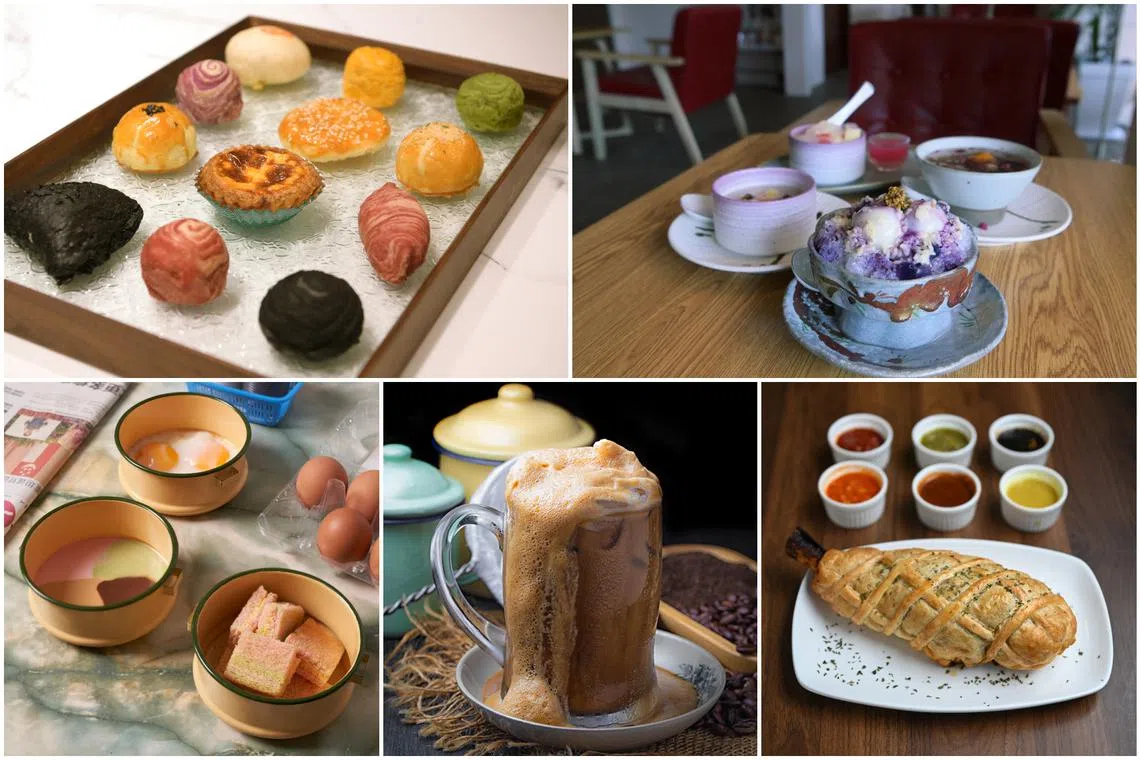
Eateries (clockwise from top left) Old Seng Choong Bake-Off Concept, Bing Tang Tang Shui, The Padangton, Great Nanyang and Lou ShangBing Tang Tang Shui are putting a modern spin on retro food and drink.
PHOTOS: NG SOR LUAN, SHINTARO TAY, GREAT NANYANG, LOU SHANG
Follow topic:
SINGAPORE – Old is perennial gold in Singapore. Despite the relentless march of progress, the determined forward thinking, people here like to bask in nostalgia, to hark back to simpler times.
Restaurants and cafes have done much to encourage that, and a crop of new ones is continuing that trend. They are conjuring in food, drink and decor the sepia-toned, warm memories of days gone by to draw customers.
That strategy is paying off too, judging by the crowds that flock to these places.
What seems to be driving the success is that these canny entrepreneurs are putting a modern spin on retro food and drink.
Doing that helps widen their pool of potential customers – older ones who actually lived through those days and younger ones seeking Instagram-worthy interiors and eats.
Recreating a Housing Board (HDB) common corridor, complete with doors, metal gates, a green trash can and even a sliding lift door that doubles as the cafe entrance, has been social media gold for influencer types. They have been beating down the simulated lift doors to Lou Shang in Prinsep Street, a cafe-bar which opened in mid-August.
Great Nanyang, a 70-seat cafe in Craig Road which also opened in mid-August, bills itself as an “olden-day kopitiam concept”.
Owner Keith Kang, 40, says: “I wanted to allow the younger generation to go back in time and have the opportunity to experience the charms of olden-day coffee houses from the 1950s to 1980s.
“The older generation can also reminisce about the good old days. It’s a wonderful way to bridge generations and create a nostalgic ambience for everyone to enjoy good traditional Nanyang food together.”
Old Seng Choong, a cake and cookie chain, recently introduced new offerings made with flaky pastry at its Bake-Off Concept stores at Paragon mall, which opened in April, and Changi Airport Terminal 2, which opened a week ago.
Customers, drawn by the smell of pastry wafting from the spanking-new-but-made-to-look-old ovens in-store, routinely snap up 1,000 Creme Brulee Tarts costing $3.90 each daily.
So chuffed by the response is founder Daniel Tay that he is looking to open what he calls an “atas kopitiam” that he might name Old Seng Choong Cold Drinks Stall. Those tall plastic tubs that some hawkers still scoop drinks such as chin chow and soya bean milk from will feature prominently.
The 53-year-old, who named his business after the confectionery shop in Marine Parade that his father ran, wants to serve “a nice hae mee”, or prawn noodles, and Hokkien mee. Kaya toast will also feature on the menu.
Will people pay top dollar for kaya toast? “With brioche, they will,” he says.
Bing Tang Tang Shui: Desserts in an office setting
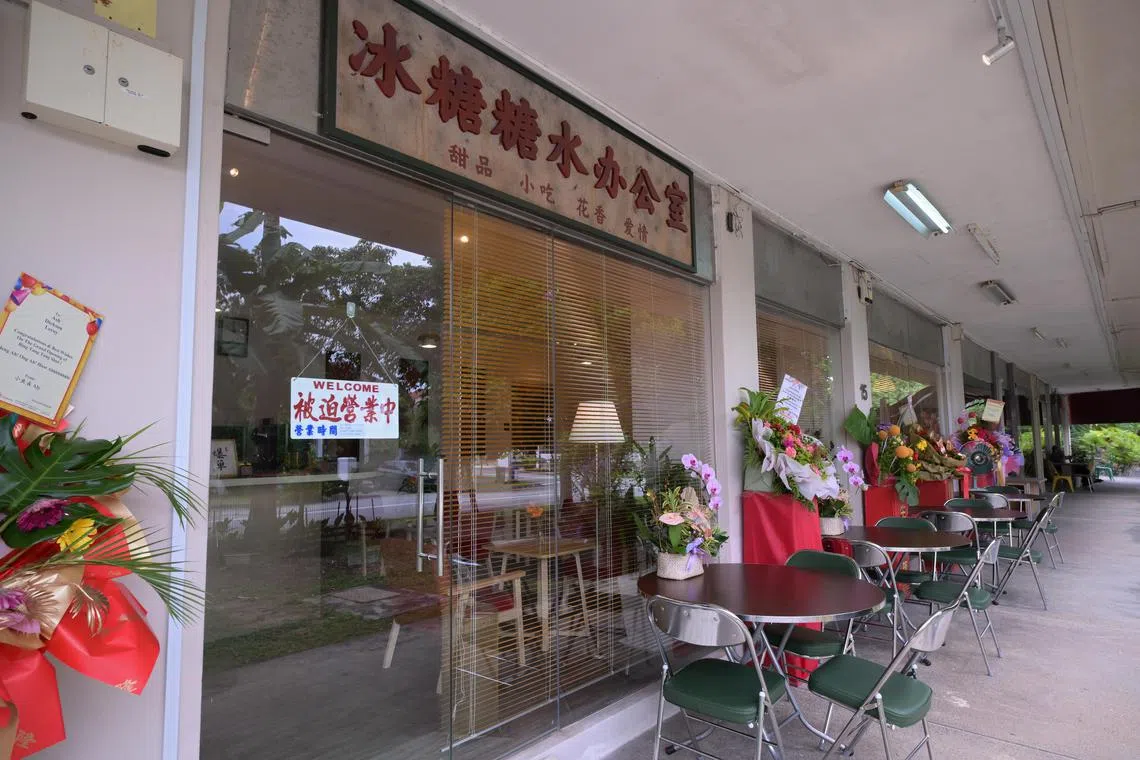
Dessert shop Bing Tang Tang Shui's 60-seat space is designed like an office, with retro lamp shades, chairs and even a “conference room” for large groups.
ST PHOTO: NG SOR LUAN
Where: 15 Thomson Hills Drive @bingtangtangshui
Open: 4.30pm to 1.30am (Mondays, Wednesdays and Thursdays), 12.30pm to 1.30am (Fridays and Saturdays), 12.30pm to midnight (Sundays), closed on Tuesdays
Info:
Nestled, nay, hidden in a quiet landed housing estate off Upper Thomson Road is two-week-old Bing Tang Tang Shui, a cafe that serves Chinese desserts sweetened with rock sugar and infused with flowers. It is far off the radar, with nary a hipster cafe as far as the eye can see.
And yet, when The Straits Times visits on a Monday afternoon, the kitchen is in all-hands-on-deck mode. Crowds over the weekend had wiped out everything. Who knew Chinese desserts could spark such a frenzy?
Co-owner Samuel Lee, 31, certainly did not. The chef, who has worked at high-end confinement hotel Kai Suites and is a private chef for a family, says: “Young people love Chinese desserts, especially orh nee. That was surprising.”
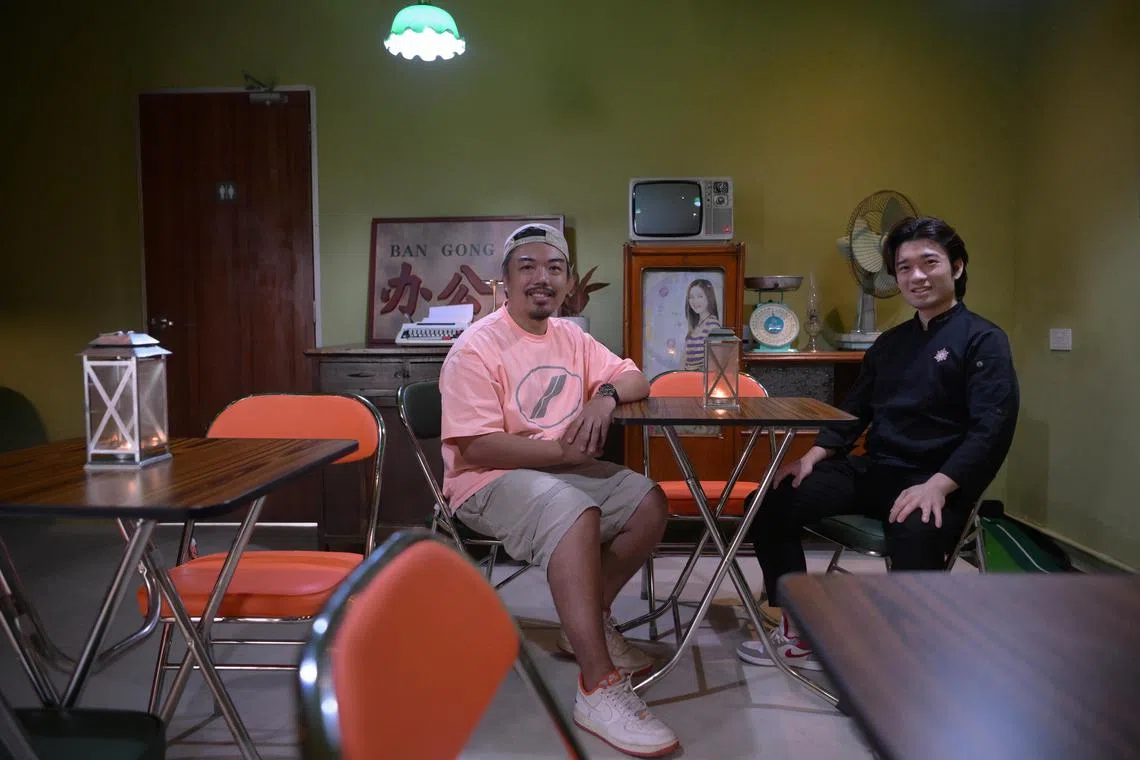
Mr Dickson Woo (left) and chef Samuel Lee are co-owners of Bing Tang Tang Shui, a cafe that serves Chinese desserts sweetened with rock sugar and infused with flowers.
ST PHOTO: NG SOR LUAN
He teamed up with Mr Dickson Woo, 35, business development manager for his family’s soya sauce business Kwong Woh Hing, and two silent partners to open the cafe. It is open until late to draw the after-dinner crowd.
The 60-seat space is designed like an office, with retro lamp shades, chairs and even a “conference room” for large groups. The menu is tucked into an old-school paper folder. Diners can opt to have desserts on one of four retro wooden office tables for $2 extra a person, and each will get a Polaroid photo of the group to commemorate their visit.
Mr Woo, who also has businesses selling chee cheong fun and fish head steamboat, sourced the furniture and decor items from China.
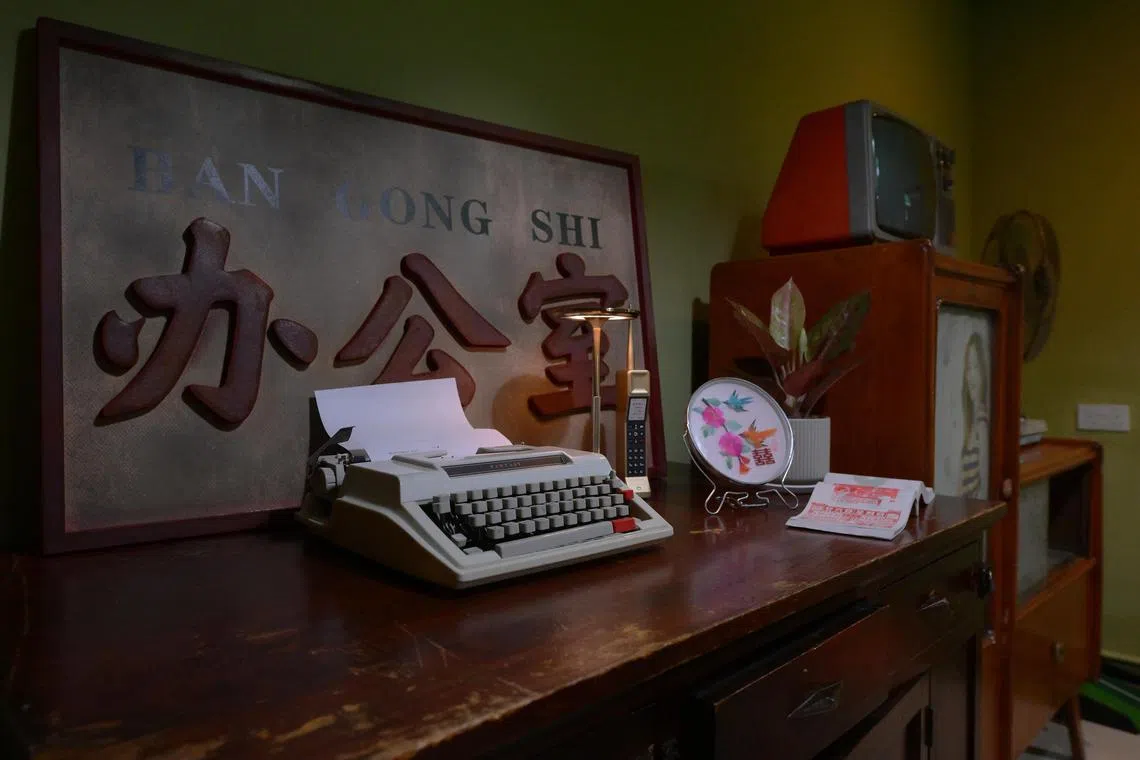
Bing Tang Tang Shui is designed to look like a retro office
The Straits Times
He says the time has come to celebrate Chinese desserts.
“I love Chinese desserts – I am Cantonese after all,” he says. “But no one is putting effort into doing it. They are all made in big pots. Well, if nobody cares, we will care.”
There are just six desserts on the menu, but four of these come in classic and modern versions.
The classic Tang Yuan ($7) features QQ black sesame paste glutinous rice balls in hot ginger soup – old ginger for depth and candied young ginger for freshness. The modern version ($12.50) is served iced.
Purple goji berry syrup is drizzled on sesame tang yuan, which sit in a rice milk sauce infused with Hakka yellow wine and lemon zest. The dessert is finished off with osmanthus caramel.
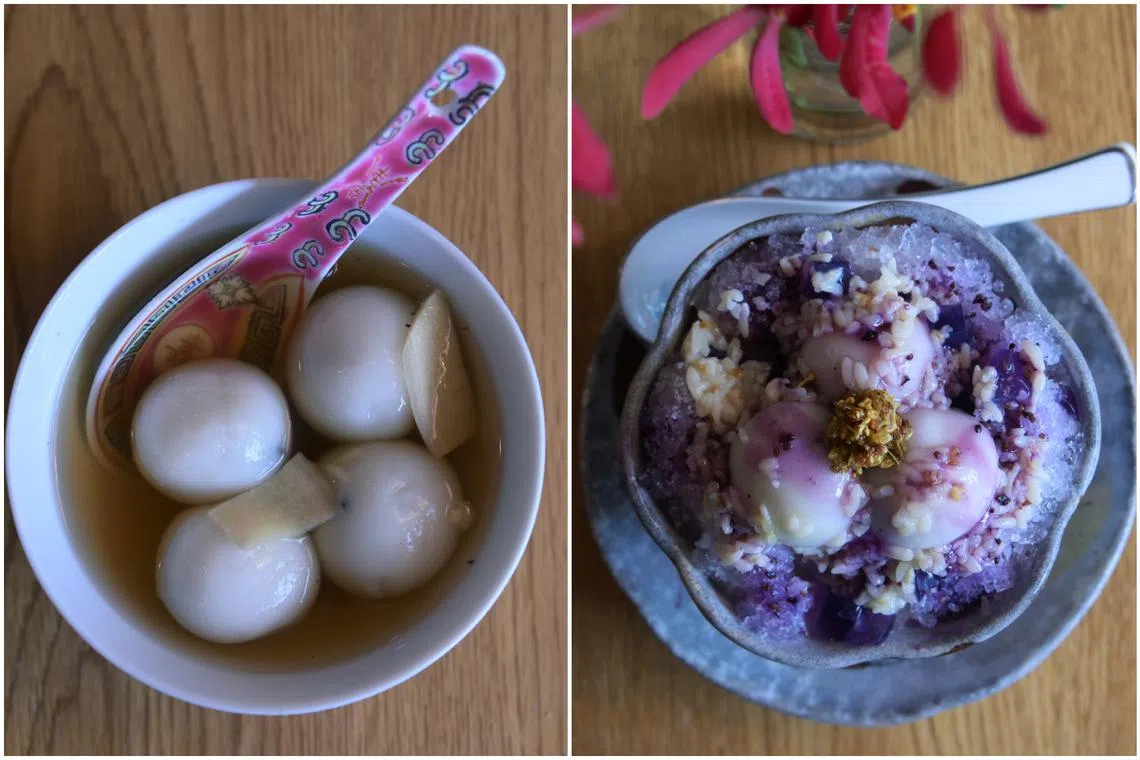
The classic (left) and modern versions of Tang Yuan at Bing Tang Tang Shui
ST PHOTOS: NG SOR LUAN
Classic Orh Nee ($7) or yam paste is topped with water chestnut sauce, fried shallots and ginkgo nuts. The updated version ($8.80) gets texture and crunch from sweet potato and fried pearl chrysanthemum buds, and is topped with roasted chrysanthemum oil, which adds a smoky layer to the dessert.
Chef Lee has had a field day discovering and using old-school ingredients such as whole candied oranges, dried sugar cane, honey dates, amaranth flowers and wild black wolfberries. Rock sugar plays a key role in his creations.
“With caster sugar, you taste the sweetness first,” he says. “In a dessert sweetened with rock sugar, you taste the freshness of the ingredients first, and the sugar is a back note.”
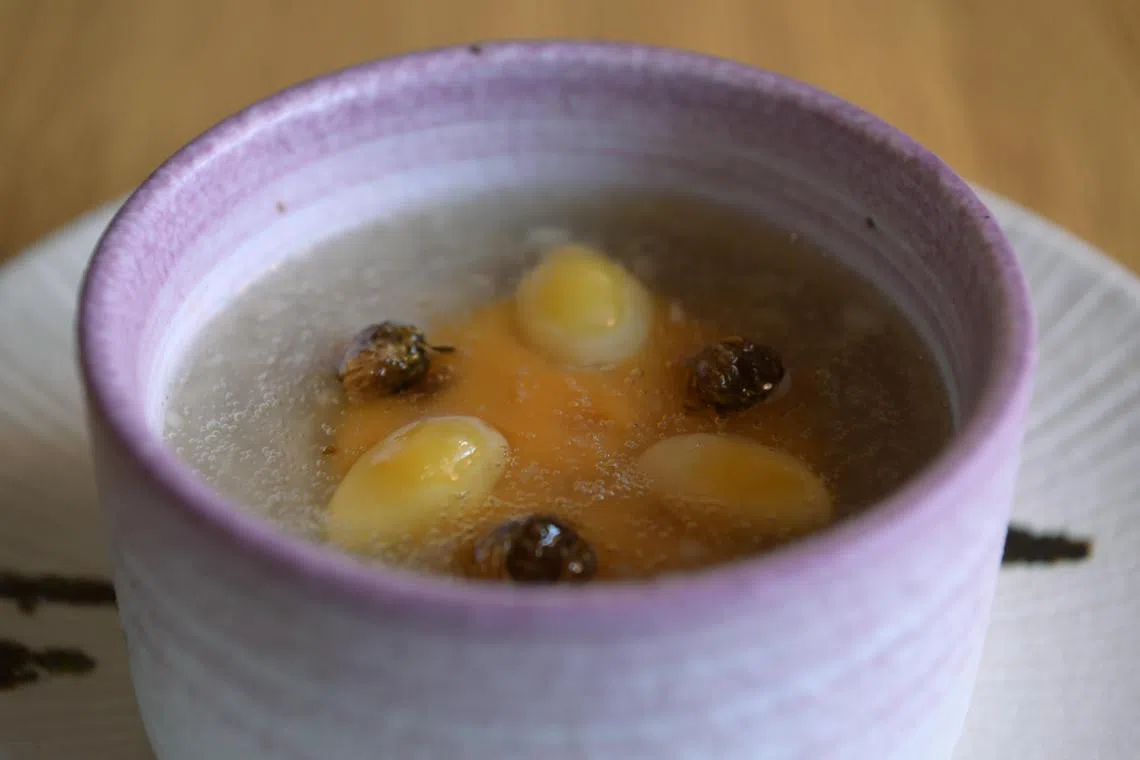
Bing Tang Tang Shui’s modern Orh Nee comes with sweet potato, fried pearl chrysanthemum buds and roasted chrysanthemum oil.
ST PHOTO: NG SOR LUAN
So far, diners have ranged in age from toddlers to retirees.
“We get couples on dates, families with children, and big groups who come after dinner,” says Mr Woo, who adds that he wants to open two more outlets and is looking for investors.
Chef Lee is working on dessert requests from customers. Topping the list are Hong Kong-style steamed egg, barley-ginkgo beancurd and desserts made with hasma, dried fatty tissue from around the fallopian tubes of Asiatic grass frogs.
“I’ve never used it before,” he says. “It’ll be interesting.”
The Padangton: Heritage in puff pastry
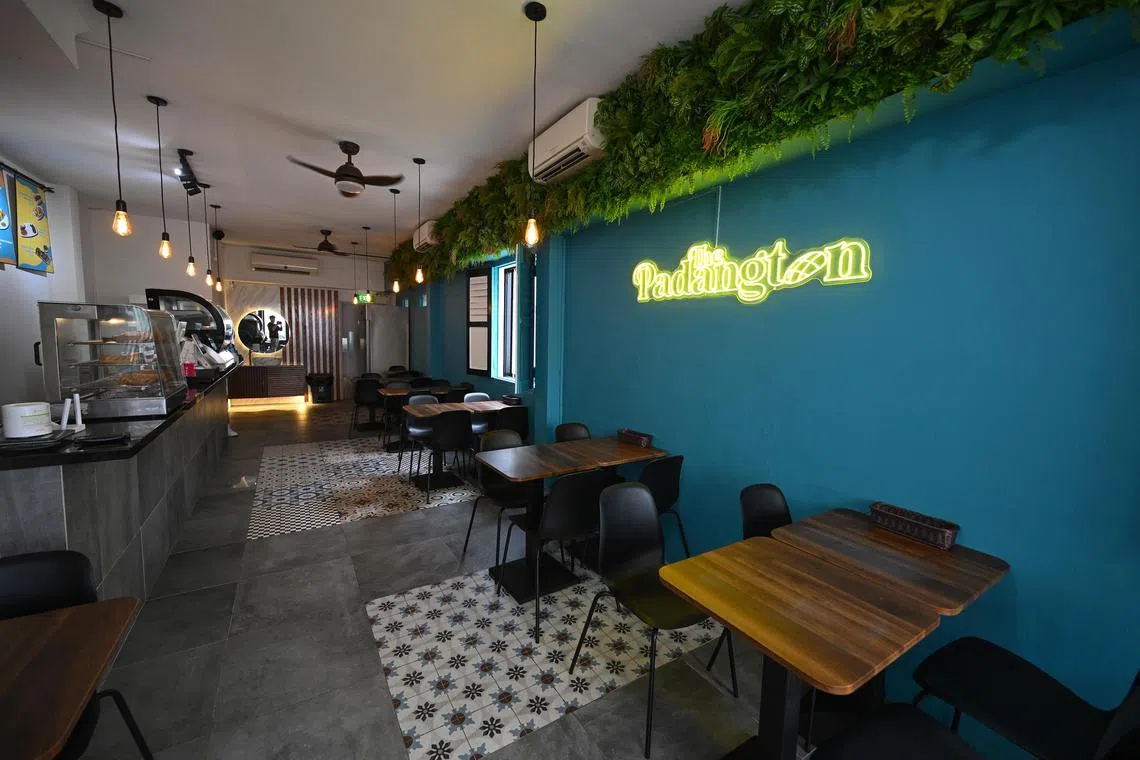
The Padangton is a 30-seat casual restaurant in the Kampong Glam area at 2 Jalan Klapa.
ST PHOTO: SHINTARO TAY
Where: 2 Jalan Klapa www.thepadangton.com
Open: 10am to 9pm (Tuesdays to Sundays), closed on Mondays
Info:
A property agent’s thank-you gift has spawned a restaurant serving heritage food with a twist.
During Hari Raya in 2022, property agent Mohammad Burhan Abdul Khalip, 44, made Beef Wellington to give to his clients as a thank-you present. It was such a hit that the recipients started asking if they could order it.
Mr Burhan’s cousins, who tasted it, also loved it, and suggested selling it.
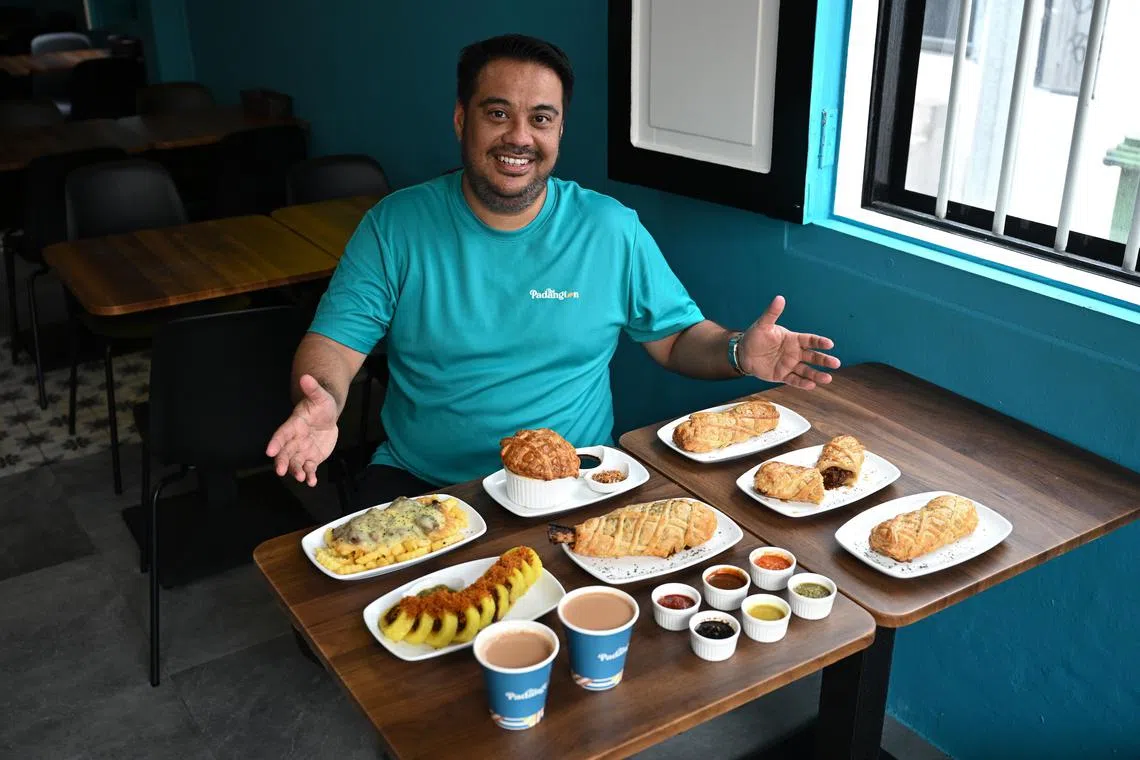
Mr Mohammad Burhan Abdul Khalip, co-owner of The Padangton, with some of his dishes.
ST PHOTO: SHINTARO TAY
Mr Burhan and three of his cousins – Mr Mohamed Fadzli Mohamed Ibrahim, 40, Mr Muhammad Farhan Rahim, 38, and Mr Mohammad Sobrie Mazelan, 39, who run a manpower supply business – decided to sell a version of it online and in food fairs in March 2023.
To make what is an expensive dish – the main ingredients are beef tenderloin and puff pastry – affordable at the fairs, they came up with the Padangton, filled with beef rendang made using a recipe by Mr Burhan’s mother.
Mr Burhan says: “Beef Wellington is so expensive to make and people wouldn’t buy it at a fair. We wanted a version that would sell easily, so we priced it at $14.50 for an individual portion. We sold out in three hours.”
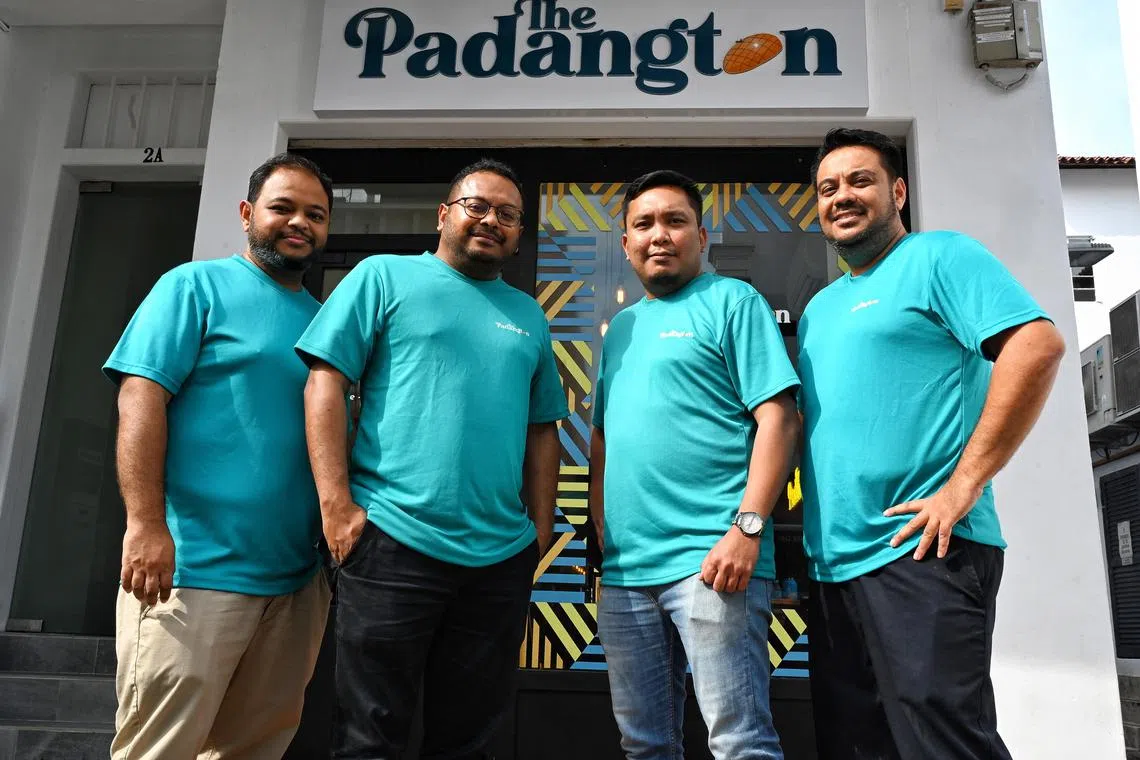
Mr Mohammad Burhan Abdul Khalip (right) and his cousins (from left) Mohamed Fadzli Mohamed Ibrahim, Muhammad Farhan Rahim and Mohammad Sobrie Mazelan opened the Padangton three months ago.
PHOTO: BERITA HARIAN FILE
In the beginning, Madam Latifar Augustar, 71, who is from Padang in Indonesia, would make the rendang, which has to be slow-cooked over six to seven hours. When the pastries started flying off the shelves, she stopped and Mr Burhan took over.
Three months ago, the cousins opened The Padangton, a 30-seat casual restaurant in the Kampong Glam area. Three cooks come in at 5am to cook the rendang every day and the pastry is now made in-house.
Beef or Chicken Rendang Padangton is priced at $14.50, and there is a striking bone-in Lamb Shank Rendang Padangton priced at $27.
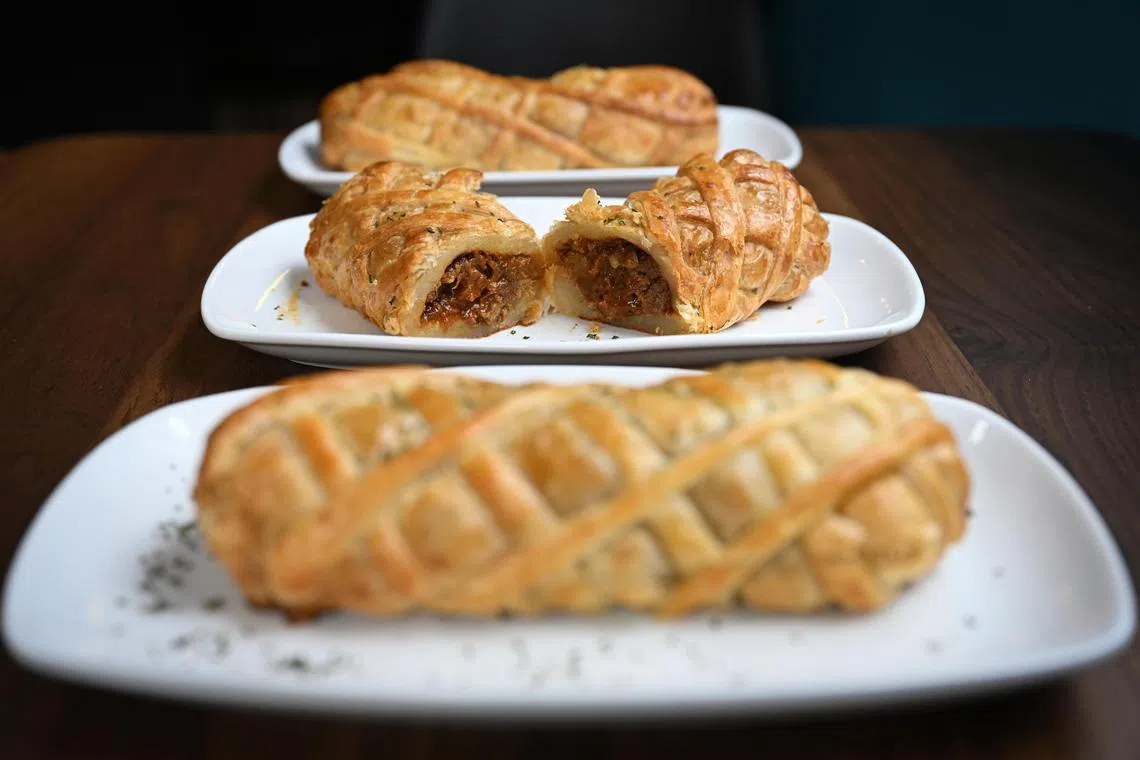
The Beef Rendang Padangton is filled with beef rendang made using a recipe by Mr Burhan’s mother.
ST PHOTO: SHINTARO TAY
Other traditional dishes given a twist include Chicken Soto Pot Pie ($12.50) and Wagyu Sate Padang ($12.50 for two). For younger customers, the restaurant also offers cheese-topped Pulled Beef or Chicken Rendang Fries ($12.50).
Mr Burhan, a father of three children aged 13, 10 and two, says: “We try to bridge the generation gap. Nowadays, younger kids growing up in Singapore forget traditional food because of the strong Western influence. My kids love the Padangton.”
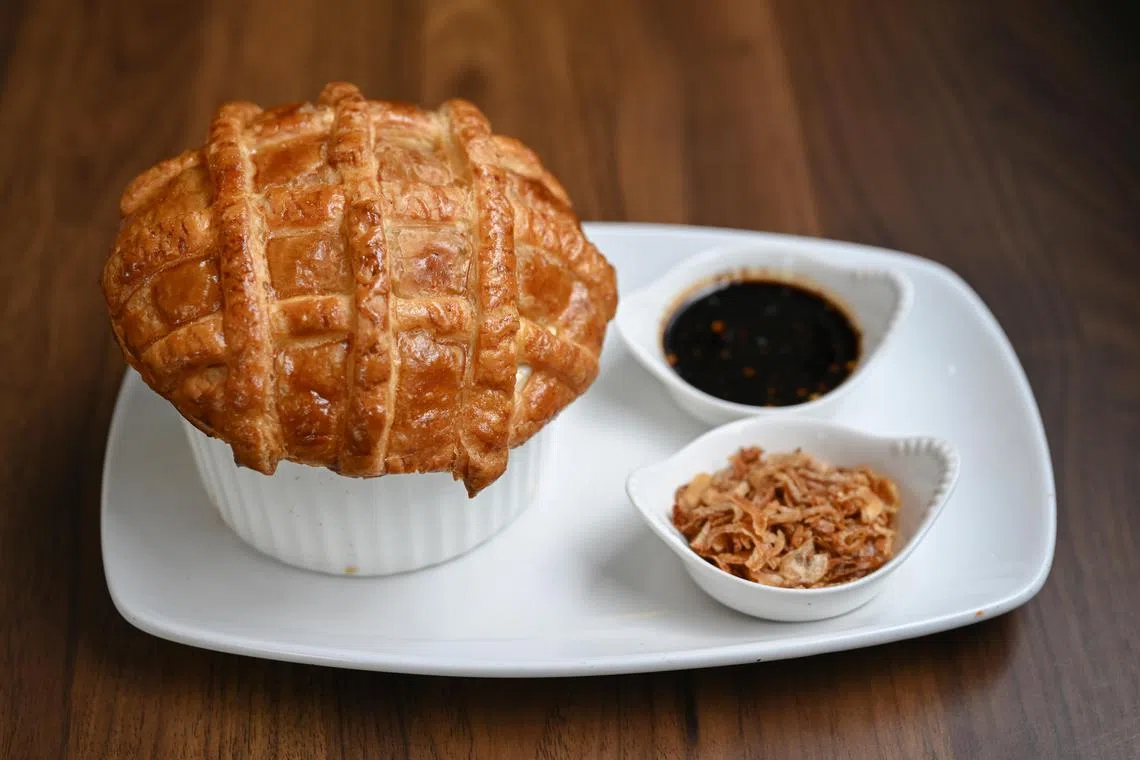
Chicken Soto Pot Pie is another traditional dish given a twist at the Padangton.
ST PHOTO: SHINTARO TAY
Also on the menu are dishes which are usually served during special occasions and Hari Raya.
Pulut Sushi Rendang Padang ($12.50) features festive turmeric coloured glutinous rice rolled up with beef rendang and topped with serunding or spiced coconut floss; and The Ketupat Rendang Set ($12.50) features rice cakes, rendang, ikan bilis and serunding.
“These are festive dishes, but sometimes, I crave them for a whole year,” Mr Burhan says.
The restaurant’s location is also strategic. Kampong Glam is filled with restaurants serving Malay food, hipster cafes and cake and pastry shops.
He says: “I feel we stand out. Most places serve very traditional nasi padang, or Western or Japanese food. There’s nothing in the middle.”

Pulut Sushi Rendang Padang, made of beef rendang rolled up in turmeric-coloured glutinous rice and topped with spiced coconut floss.
ST PHOTO: SHINTARO TAY
Next on the menu at the restaurant might be a Padangton made with Impossible, the meat substitute, and he is looking at how to infuse it with rendang flavour without having it break apart over the long cooking time.
The cousins are also looking to widen their reach, to Malaysia, and plan to start by doing pop-ups in malls, to see if people there will take to their Padangton.
“People in Kuala Lumpur like innovative food and we want to try out our concept there, to see if they accept it,” says Mr Burhan.
Great Nanyang Heritage Cafe: Olden-day kopitiam

Walking into Great Nanyang Heritage Cafe is like stepping back into the past.
PHOTO: GREAT NANYANG
Where: 5 Craig Road @greatnanyang
Open: 7.30am to 3pm (last order), 5 to 8.30pm (last order) daily
Info:
Movie set or cafe, it is hard to tell. Walking into Great Nanyang Heritage Cafe is like stepping back into the past, without the grit and grime.
Owner Keith Kang, 40, who also runs the popular Yang Ming Seafood, with restaurants in Bishan and Ubi, sourced the photographs, posters, furniture, tiles, metal gates, mooncake moulds that adorn a wall, vinyl records, old phones and other vintage paraphernalia from antique shops here and in Malaysia to recreate the feel of an olden-day kopitiam.
The renovations cost about $400,000.
Mixed in with all this are family heirlooms, including a charcoal-powered steam iron, kettle, sewing machine and teapots that used to belong to Mr Kang’s grandmother.
He named his latest venture, a 70-seater that opened on Aug 16, after the geographical region encompassing the southern coastal areas in China and South-east Asia. Even the cafe’s location, in the Tanjong Pagar area, is significant for him.
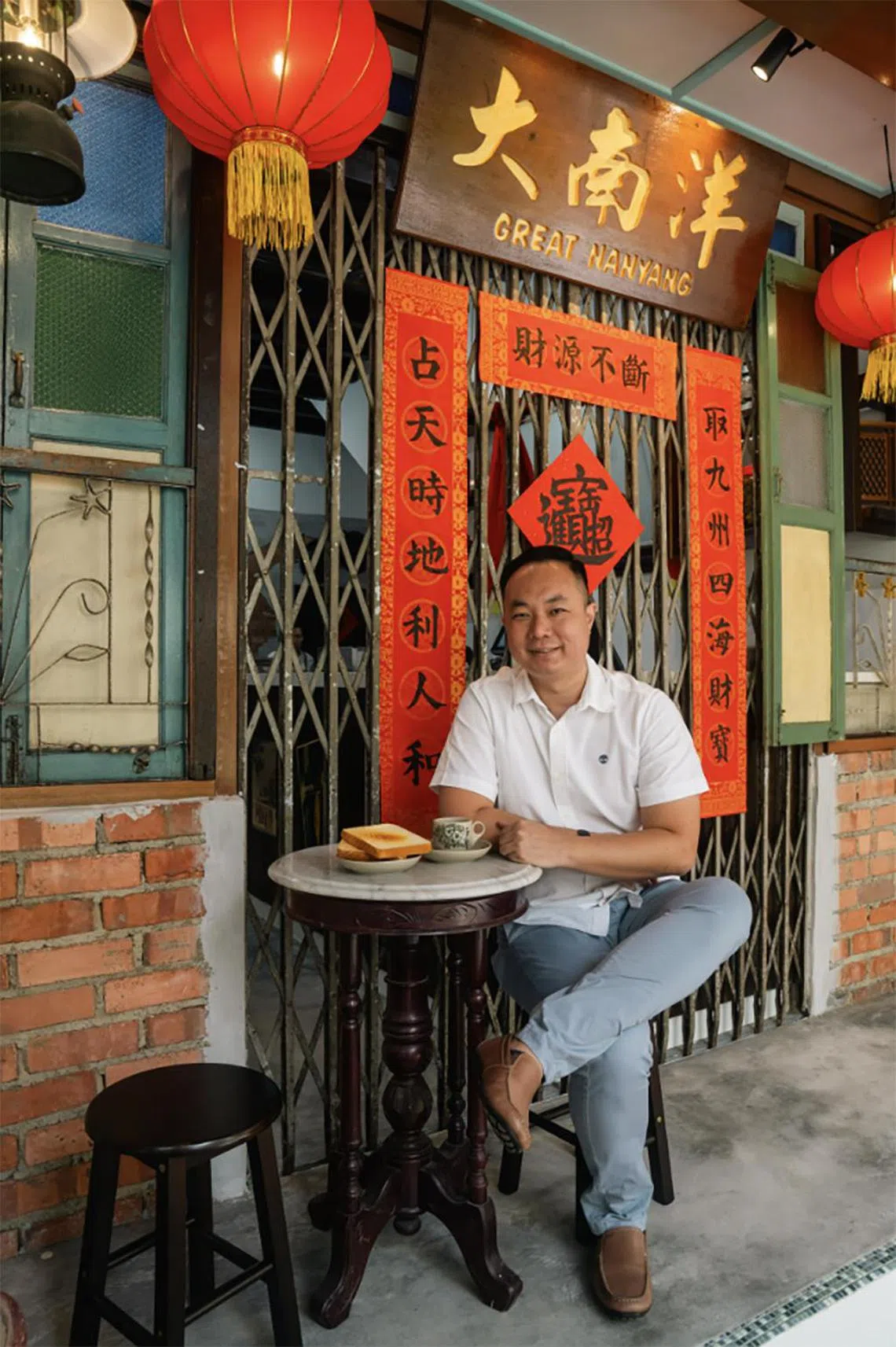
To recreate the feel of an olden-day kopitiam for Great Nanyang, Mr Keith Kang sourced vintage decor and paraphernalia from antique shops here and in Malaysia.
PHOTO: GREAT NANYANG
“Craig Road was a residential area for the poor, including rickshaw pullers, dock workers and members of triad gangs,” he says, adding that it was also a residential area for the Chinese community before British colonial times because it was close to the Singapore River, a hive of commercial activity. “I feel that there is no better place to open a throwback kopitiam.”
The menu is drawn from his memories growing up in Penang.
For breakfast, there is Hand Made Kaya Toast featuring bread made by an old-school supplier. The price depends on the bread: traditional ($2.50), thick ($2.70) or wholemeal ($3).
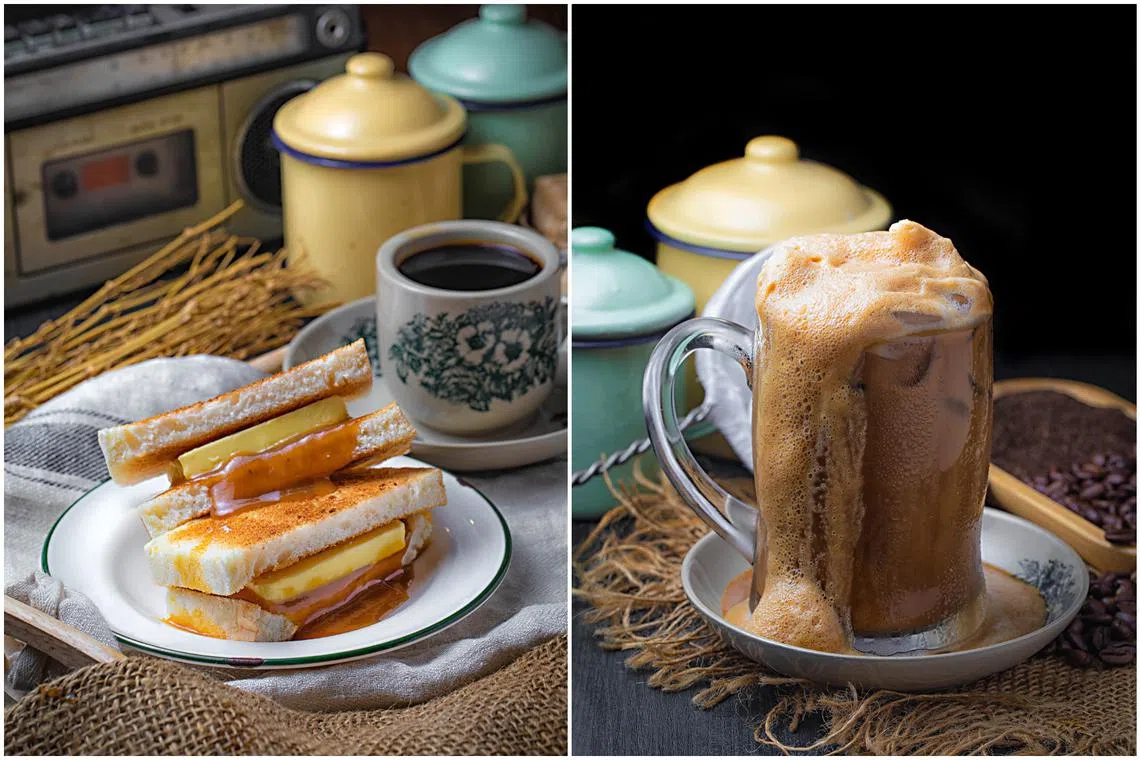
Traditional Kaya Butter Toast and Hainanese Yuan Yang Ice at Great Nanyang.
PHOTOS: GREAT NANYANG
Apart from kopi and teh, drinks include Coconut Coffee ($5.90), made with Nanyang coffee and sweet condensed coconut milk; and Golden Lime ($3.50), a kumquat drink made with fruit preserved in-house.
There is also an all-day selection of easy-to-like dishes, including bestsellers Nasi Lemak Kukus (from $8.90) and Signature Hainanese Chicken Cutlet ($15.90). Other offerings include Penang Assam Laksa ($8.90), Prawn Paste Chicken Wing (from $6.90 for four), and Hainanese Prawn Fritters ($12.90).
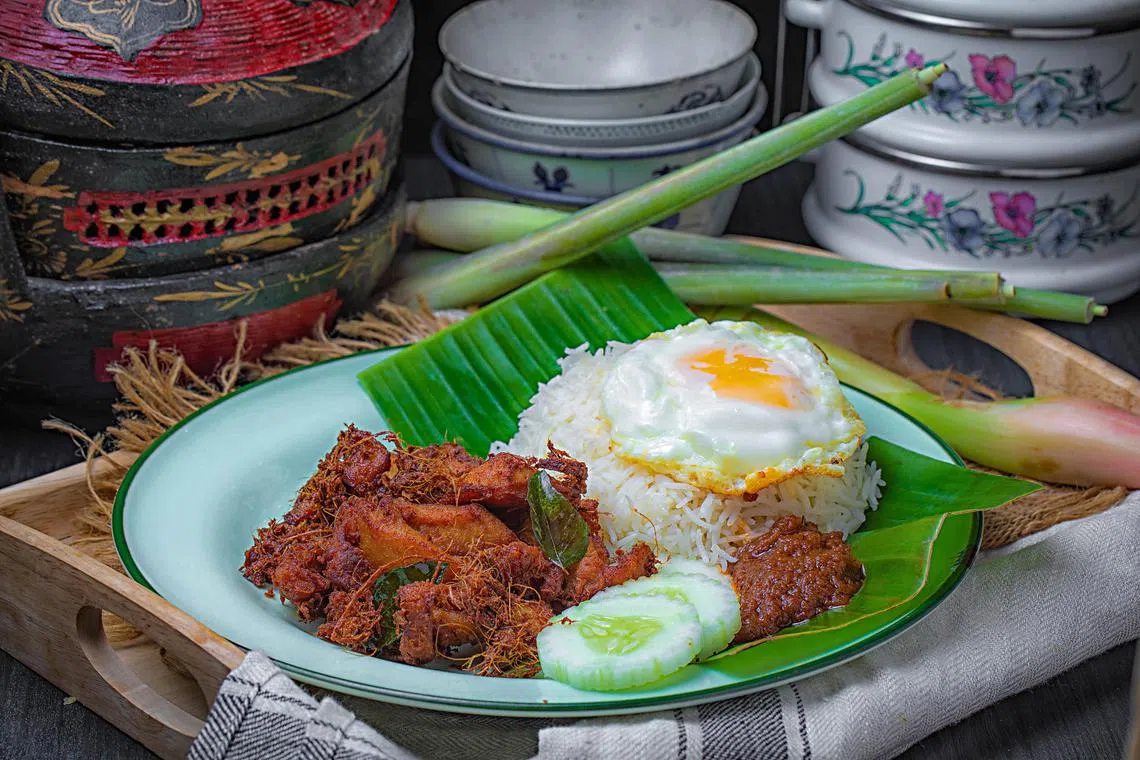
Chicken Berempah Leg Nasi Lemak Kukus at Great Nanyang.
PHOTO: GREAT NANYANG
Also on the menu is a drink called Hor Ka Sai ($3 for hot, $5 for cold), which Mr Kang calls the “Nanyang version of a mocha”, being a blend of Nanyang coffee and Milo. The Hokkien name translates to “tiger bites lion” and the drink came about in the 1950s in Taiping, a Malaysian town.
A team of cooks from Malaysia and Singapore cooks all the food from recipes it worked on with Mr Kang.
He says: “I hope to be able to preserve a part of our culture and food heritage that is fast disappearing, and share it with generations to come in a time capsule of a kopitiam called Great Nanyang.”
Lou Shang: HDB life
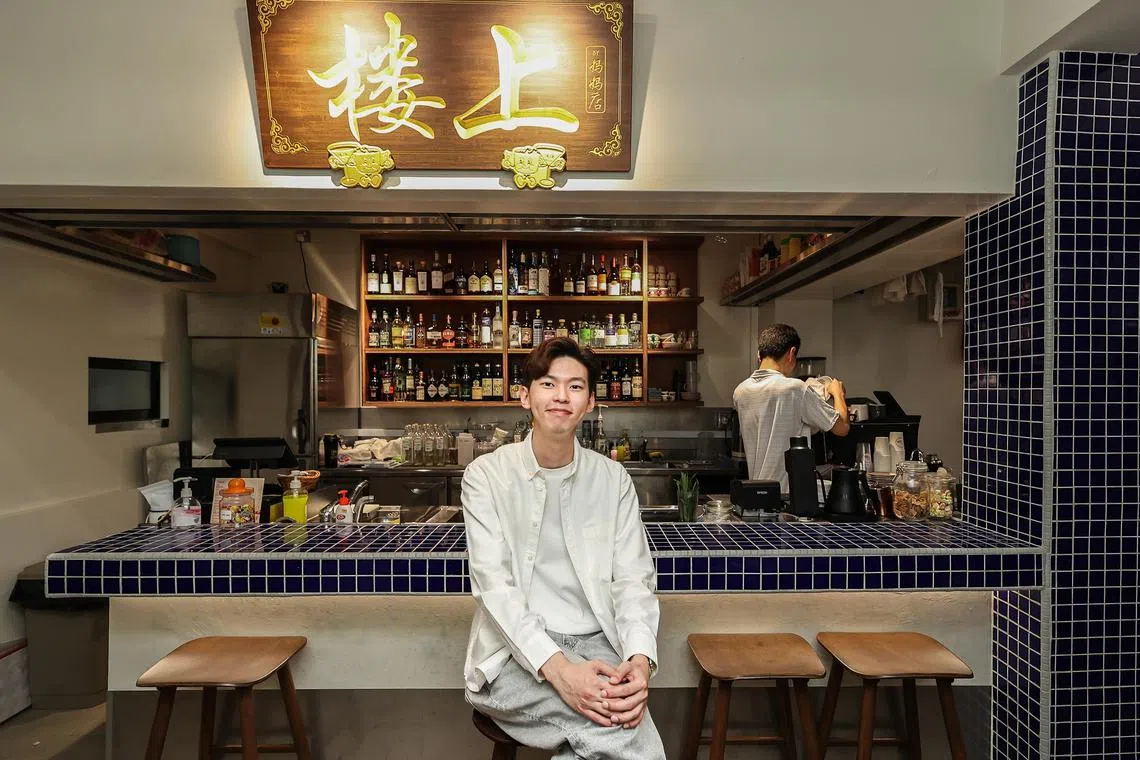
Mr Sebastian Ang's concept for Lou Shang by Mama Diam in Prinsep Street – a cafe by day and cocktail bar by night – is inspired by his childhood memories of living in a third-storey Housing Board flat in Lorong Ah Soo.
ST PHOTO: HESTER TAN
Where: 38 Prinsep Street www.mamadiamsg.com
Open: Cafe, 9am to 5pm daily; bar, 6 to 11pm (Tuesdays to Thursdays), 6pm to midnight (Fridays and Saturdays); bar is closed on Sundays and Mondays
Info: Go to
Looking back has paid off handsomely for entrepreneur Sebastian Ang.
The pandemic shuttered the events company the 31-year-old worked for, and he decided to get into the food and beverage business.
In August 2021, with a business partner, he opened a bar in Prinsep Street hidden behind a replica of a sundries shop. Mama Diam’s facade and speakeasy vibe became an instant draw.
In February 2023, he opened, with other business partners, the 130-seat Synthesis in Suntec City, with food and drink themed around traditional Chinese medicine.
When the space above Mama Diam became available earlier this year, he opened the 32-seat Lou Shang, cafe by day, cocktail bar by night.
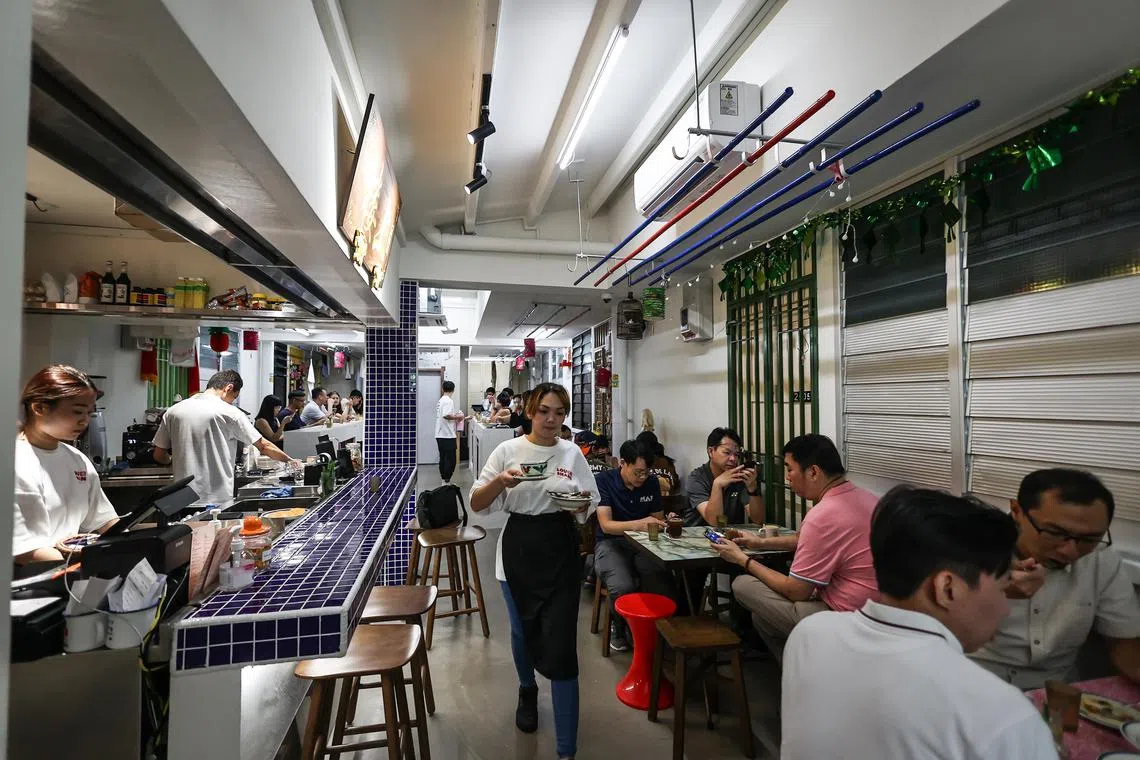
The decor and menu offerings at Lou Shang are themed around the idea of home.
ST PHOTO: HESTER TAN
The place, which cost $200,000 to set up, completes his childhood memories of living in a third-storey HDB flat in Lorong Ah Soo. He would visit the sundries store on his way back from school and climb up the stairs to get home.
Indeed, the decor and menu offerings are themed around the idea of home.
The entrance to Lou Shang, upstairs in Chinese, would be familiar to eight in 10 Singaporeans who live in HDB flats. There is the familiar green trash can – bought off Carousell – and even a mini bank of metal mailboxes that are found in every HDB block.
Once through the automated sliding door made to look like a lift door, the visitor enters what seems like a chaotic HDB corridor, complete with familiar wooden doors, metal gates and a bar counter sporting the blue and white tiles that adorn the tables at void decks.
It is chaotic only because the place is mobbed; filled to gills with people busy eating, drinking and taking photographs.
On the menu, familiar food is given a twist. The quintessential Singapore breakfast of kaya toast and eggs is called Rainbow Roti ($9), with cubes of colour-streaked bread to be dipped into , and soft-boiled eggs.

Lou Shang’s Rainbow Roti, which comes with kaya, milk, chocolate and bandung custard as well as soft-boiled eggs.
PHOTO: LOU SHANG
Pasta is made in-house for offerings such as Chilli Crab-tivating ($20), crab and ricotta ravioli in chilli crab sauce.
Other offerings include Sarsi Cauliflower Poppers ($13), featuring battered cauliflower florets with a glaze made with the soft drink.
For dessert, there is Tutu Kueh ($13), which looks like an upsized version of the steamed cake but is vanilla chiffon cake with a gula melaka core covered with coconut mousse.

Lou Shang’s desserts (from top): Tutu Kueh, Cinnacake and Gula Melaka Tiramisu.
PHOTO: LOU SHANG
Cocktails include Kaffir Lime Negroni ($24) with makrut lime-infused vodka; Kopi & Dream ($22) with spiced rum and coffee liqueur; and Osmanthus ($26), using gin infused with the flowers.
Mr Ang says his customers are diverse – families with kids, couples on dates and groups of friends. Tourists have also found their way to the place.
He says: “I hope this place can be an iconic museum for our foreign friends. HDB living is exclusive to Singapore. I have been to a lot of modern restaurants and hidden bars, but there hasn’t been one that represents Singapore. Why isn’t there a bar or restaurant that resonates with Singapore culture?”
Naysayers have questioned his motives, asking if he is mocking people who live in HDB flats.
He says that when he was 12, his family moved from Lorong Ah Soo to an HDB flat in Sengkang, where they still live. “There is nothing to mock,” he says.
Old Seng Choong Bake-Off Concept: Old-school pastry, updated

Pastry selection at Old Seng Choong Bake-Off Concept at Paragon
ST PHOTO: NG SOR LUAN
Where: B1-14 Paragon Shopping Centre, 290 Orchard Road; and 02-175 Changi Airport Terminal 2 Transit Lounge, 60 Airport Boulevard www.oldsengchoong.com
Open: 10am to 9pm daily (Paragon); 6 to 1am daily (Changi Airport)
Info:
Customers follow the smell of hot butter to Old Seng Choong at the basement of Paragon, a mall in Orchard Road. What they find are not croissants, but bakes made with old-school flaky pastry, the kind used for egg tarts and other Chinese bing.
Except, of course, that founder Daniel Tay, 53, has retooled traditional pastries for contemporary taste buds.

Old Seng Choong founder Daniel Tay says he worked with a Hong Kong chef to nail the pastry recipe.
ST PHOTO: NG SOR LUAN
Instead of shortening, he uses butter for all the pastries except one, which is made with lard. And while the pastries have traditional fillings such as mung beans, black beans, white lotus paste and red beans, they also have modern – and luxe – touches.
There is Parma Ham With Shallot Oil ($4.50), flaky pastry filled with white lotus paste and dry-cured Italian ham. Black Truffle Salted Yolk ($4.50) combines lotus paste with truffle oil and salted egg yolk, and it is encased in charcoal-coloured pastry.
Another black pastry is filled with Truffle Char Siew ($4.50). Taiwanese Mung Bean Pastry ($4.50) has mung bean paste and braised pork encased in lard pastry.

Taiwanese Mung Bean Pastry at Old Seng Choong Bake-Off Concept has mung bean paste and braised pork encased in lard pastry.
ST PHOTO: NG SOR LUAN
Old-school egg tarts are given a caramelised sugar topping, becoming Creme Brulee Tart ($3.90).
These and other pastries are baked at intervals through the day in a Taiwan-made oven that fits in with the retro-luxe vibe of the brand.
Mr Tay says he worked with a Hong Kong chef to nail the pastry recipe.
“He has the experience, I have the taste,” he says. “It took many months to make it right. I didn’t want the taste of the fat sticking on my tongue and, most importantly, the pastry has to be puffy and flaky.”
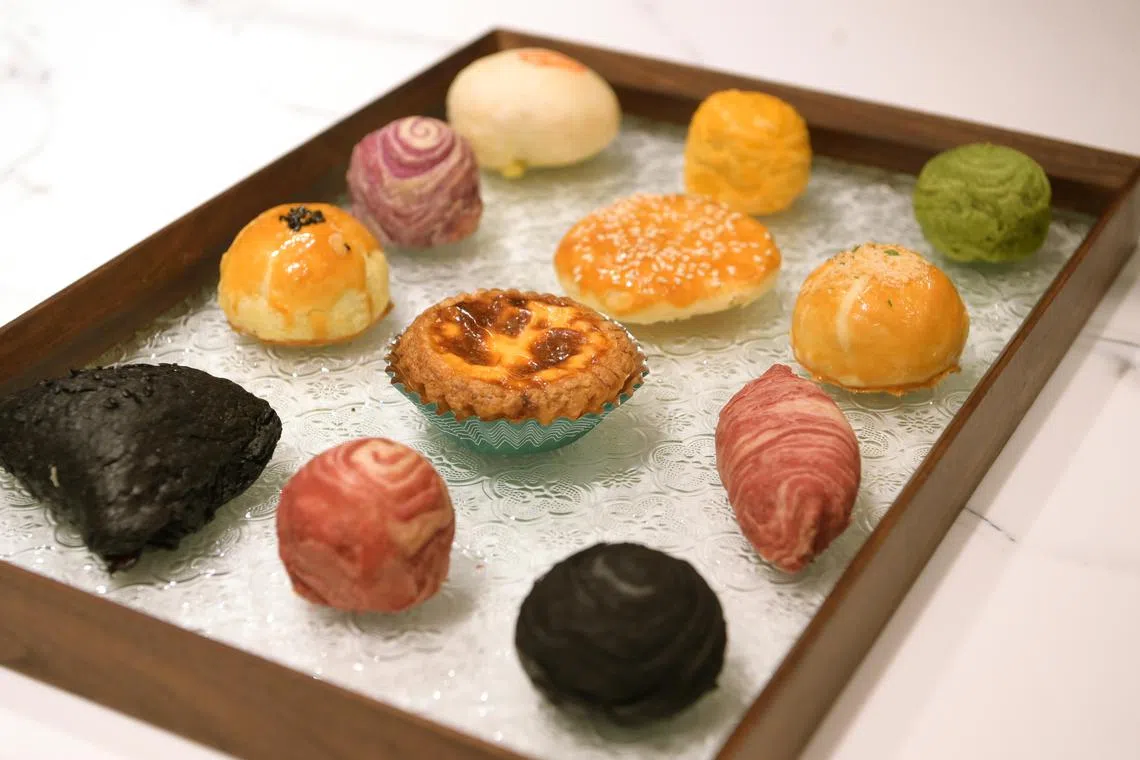
The pastry selection at Old Seng Choong Bake-Off Concept at Paragon
ST PHOTO: NG SOR LUAN
In coming up with the new offerings, he was conscious not to go old-old style, but to strike a balance with what he calls old-new style.
He says: “We want to attract the young crowd, educate them about the nice sweets we have. Good sweets don’t come only from ang moh countries.
“I would also encourage young pastry chefs to go deep into our traditional sweets, instead of just looking at Western-style pastries.”


